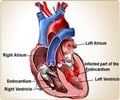Paroxetine - a common antidepressant drug used to treat depression and anxiety disorders can help prevent heart failure, say University of Michigan researchers.

Although so-called "off target" effects are known for many commonly used drugs, this is the first report that identifies a direct link between a specific SSRI and a protein target in the signal system they study, said Kristoff Homan, a postdoctoral fellow in Tesmer's lab.
The paper, "Paroxetine is a Direct Inhibitor of G Protein-Coupled Receptor Kinase 2 and Increases Myocardial Contractility," was published electronically ahead of print on Aug. 21 in ACS Chemical Biology.
The discovery almost did not happen. "It was completely serendipitous," Homan said.
Before beginning a larger search for compounds that would inhibit GRK2, the researchers screened a small library of approximately 2,000 compounds that contains many FDA-approved drugs as a test of their screening procedure—and found that paroxetine binds to and inhibits the activity of GRK2.
GRK2 becomes increasingly expressed as the system that regulates normal heartbeat and the strength of the heart's contractions weakens. Paroxetine, the team found, improved the strength of the heart's contractions in an animal model without interfering with the heart rate.
Advertisement
But if the researchers can identify modifications to the chemical structure of paroxetine that improve potency while decreasing SSRI activity, which Homan thinks they can do, the team hopes to start the process of optimization and to develop these compounds into therapeutic leads within the next several years, he said.
Advertisement














